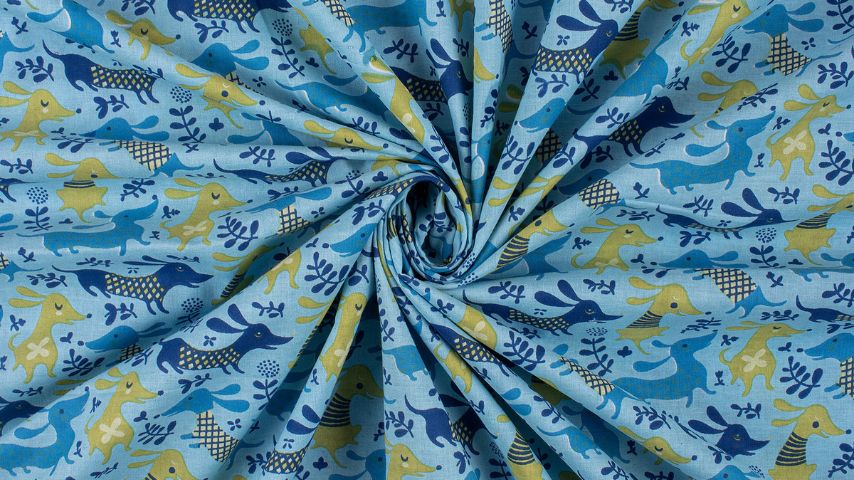The Rich History of Hand Block Printing
Hand block printing is an ancient textile art that has endured for centuries, cherished across cultures for its precision, beauty, and handcrafted authenticity. Originating in India, China, and parts of the Middle East, this traditional craft has captivated generations with its blend of meticulous detail and cultural storytelling.
At the heart of the hand block print fabric lies a commitment to artisanal integrity. Skilled artisans carve intricate designs into teak wood blocks, dip them in natural dyes, and carefully press them onto cotton, silk, or linen fabrics by hand. Every stamp is a testament to craftsmanship, patience, and legacy.
How Hand Block Print Fabric Is Made
1. Design and Block Carving
The process begins with a unique design drawn by hand. These motifs are often inspired by nature, mythology, and geometric patterns. Once finalised, the design is carefully chiselled onto a wooden block by master craftsmen using traditional tools. Each colour in the final design requires a separate block, making the creation both labour-intensive and richly detailed.
2. Preparation of Fabric
Before printing, the chosen fabric undergoes an extensive washing and bleaching process to remove starch, oils, and impurities. This ensures the fabric is clean and absorbent, ready to take on the natural dyes.
3. Dyeing and Printing
Using natural pigments made from plants, minerals, and earth, artisans dip the carved wooden block into dye and stamp it onto the fabric with precision. This process is repeated for every colour, layer by layer, with alignment being key. A single piece of fabric can take days or even weeks to complete, depending on complexity.
4. Washing and Finishing
After printing, the fabric is dried in sunlight, washed to fix the dyes, and sometimes steamed to enhance the richness of the colours. It’s then pressed and prepared for final use in garments, upholstery, home décor, or accessories.
Why Choose Hand Block Print Fabric?
Sustainable and Eco-Friendly
One of the biggest advantages of hand block print fabric is its sustainability. Most artisans use organic cotton, natural dyes, and manual processes, reducing carbon footprints and minimising chemical waste.
Cultural and Artistic Value
Owning a piece of hand block print fabric is like owning a piece of living history. Each item carries the story of the artisan, the region, and the generations that have preserved this art form.
Uniqueness and Character
No two block-printed textiles are ever the same. Slight variations in prints, colour saturation, or alignment reflect the handmade charm and distinguish each piece as one-of-a-kind.
Applications of Hand Block Print Fabric
Fashion Industry
Designers across the globe are embracing hand block printed fabrics in both contemporary and traditional silhouettes. From flowing maxi dresses and bohemian skirts to elegant kurta sets and scarves, the versatility of this fabric is unmatched.
Home Décor
Hand block prints have found a vibrant place in home interiors. Popular choices include curtains, bedspreads, tablecloths, cushion covers, and even wall art. The natural colour palette and intricate detailing bring warmth and authenticity to any living space.
Craft Projects and Accessories
Craft enthusiasts often use hand block print fabrics for patchwork quilts, tote bags, journals, and DIY home accents. Its artistic appeal adds charm to everyday items.
Popular Regions Known for Hand Block Printing
Bagru, Rajasthan
Known for its earthy tones and floral motifs, Bagru block prints are widely celebrated for their use of natural dyes and traditional mud-resist techniques.
Sanganer, Rajasthan
Sanganer produces finer, more delicate prints on white or off-white fabrics. These patterns often feature intricate florals, vines, and symmetrical geometry.
Ajrakh, Gujarat and Sindh
Ajrakh block printing stands out with its deep indigo and crimson hues, using complex symmetrical designs that are both bold and symbolic. The printing process can involve up to 16 different steps.
How to Care for Hand Block Print Fabric
To preserve the integrity and vibrancy of your hand block print fabric:
-
Hand wash separately in cold water using mild detergent.
-
Avoid direct sunlight during drying to prevent colour fading.
-
Iron on the reverse side, if needed, preferably at a low temperature.
-
Do not bleach or tumble dry.
These precautions ensure that your fabric remains beautiful and durable for years to come.
Where to Buy Authentic Hand Block Print Fabric
Look for artisan cooperatives, sustainable fashion brands, or certified fair-trade sources to buy genuine block-printed textiles. Many online platforms now directly connect buyers with artisan communities, ensuring ethical sourcing and fair wages.
The Future of Hand Block Printing
Despite facing challenges from mass production and digital printing, hand block printing is experiencing a revival. As more consumers value sustainability, slow fashion, and handmade goods, the demand for authentic textiles like hand block print fabric continues to grow.
Designers, interior decorators, and ethical fashion advocates are collaborating with artisan clusters to modernise traditional designs, integrate them into new collections, and bring global recognition to this ancient art form.
Conclusion
Hand block print fabric is not just a material—it’s a symbol of heritage, craftsmanship, and sustainable living. Its journey from carved wooden blocks to beautiful textiles reflects a tradition deeply rooted in culture and care. By choosing block-printed fabrics, we embrace a slower, more meaningful approach to fashion and design, supporting artisans, preserving ancient techniques, and adding timeless beauty to our lives.
- Hand Block Print Fabric: A Timeless Craft of Art and Heritage
- Hand block print fabric is not just a material—it's a symbol of heritage, craftsmanship, and sustainable living.
- Hand Block Print Fabric, Cotton Fabric
Related posts:
 Love That Lasts: The Rise of Lab Diamond Wedding Bands mined diamonds
Love That Lasts: The Rise of Lab Diamond Wedding Bands mined diamonds
 Why Aimé Leon Dore Is More Than Just a Brand – It’s a Lifestyle Choice
Why Aimé Leon Dore Is More Than Just a Brand – It’s a Lifestyle Choice
 Nofs and Nofs Signature Tracksuit Nofs and Nofs Signature Tracksuit
Nofs and Nofs Signature Tracksuit Nofs and Nofs Signature Tracksuit
 Top Ways For Eid ul Adha Gifts and Card Wishes in Pakistan – 2025
Top Ways For Eid ul Adha Gifts and Card Wishes in Pakistan – 2025
 Syna World Redefining the Intersection of Streetwear, Culture, and Identity
Syna World Redefining the Intersection of Streetwear, Culture, and Identity
 Add a bold edge to your look with a Stussy hoodie. It’s not just stylish—it brings raw, unapologetic attitude. From graphic designs to oversized fits and unique colors, it’s the perfect streetwear staple. Pair it with boots, distressed denim, or a leather jacket to stand out effortlessly. This hoodie doesn’t follow trends—it sets them.
Add a bold edge to your look with a Stussy hoodie. It’s not just stylish—it brings raw, unapologetic attitude. From graphic designs to oversized fits and unique colors, it’s the perfect streetwear staple. Pair it with boots, distressed denim, or a leather jacket to stand out effortlessly. This hoodie doesn’t follow trends—it sets them.
 Discover the Elegance of Cainte Watches & Where to Buy………….
Discover the Elegance of Cainte Watches & Where to Buy………….
 From Classic to Bold: Best Box Braid Styles You’ll Absolutely Love
From Classic to Bold: Best Box Braid Styles You’ll Absolutely Love







